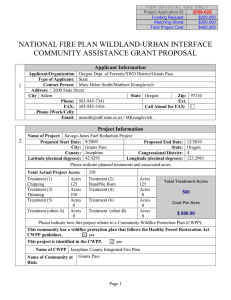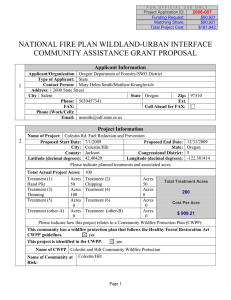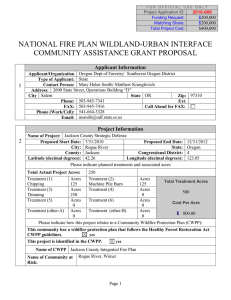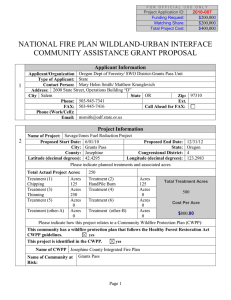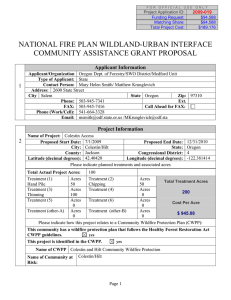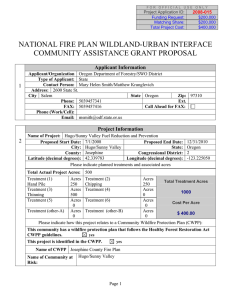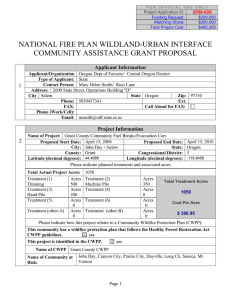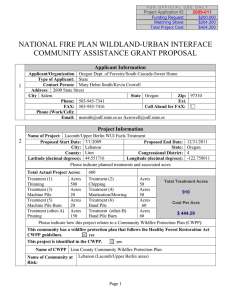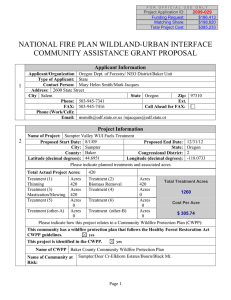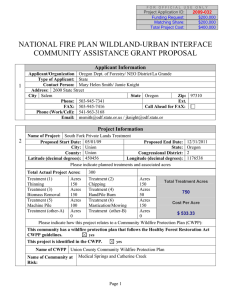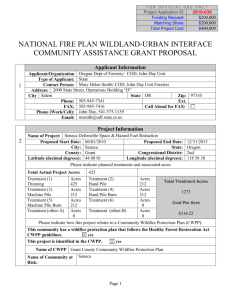NATIONAL FIRE PLAN WILDLAND-URBAN INTERFACE COMMUNITY ASSISTANCE GRANT PROPOSAL Applicant Information
advertisement
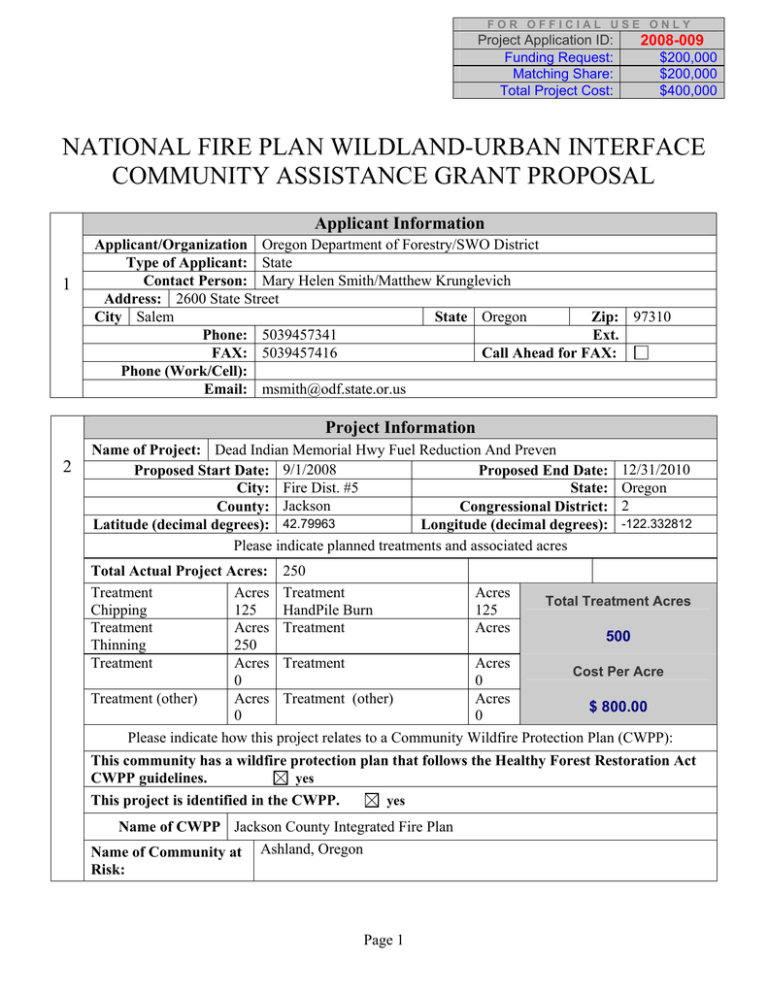
FOR OFFICIAL USE ONLY Project Application ID: Funding Request: Matching Share: Total Project Cost: 2008-009 $200,000 $200,000 $400,000 NATIONAL FIRE PLAN WILDLAND-URBAN INTERFACE COMMUNITY ASSISTANCE GRANT PROPOSAL Applicant Information 1 Applicant/Organization Oregon Department of Forestry/SWO District Type of Applicant: State Contact Person: Mary Helen Smith/Matthew Krunglevich Address: 2600 State Street City Salem State Oregon Zip: 97310 Phone: 5039457341 Ext. FAX: 5039457416 Call Ahead for FAX: Phone (Work/Cell): Email: msmith@odf.state.or.us Project Information 2 Name of Project: Dead Indian Memorial Hwy Fuel Reduction And Preven Proposed Start Date: 9/1/2008 Proposed End Date: City: Fire Dist. #5 State: County: Jackson Congressional District: Longitude (decimal degrees): Latitude (decimal degrees): 42.79963 Please indicate planned treatments and associated acres 12/31/2010 Oregon 2 -122.332812 Total Actual Project Acres: 250 Treatment Acres Treatment Acres Total Treatment Acres Chipping 125 HandPile Burn 125 Treatment Acres Treatment Acres 500 Thinning 250 Treatment Acres Treatment Acres Cost Per Acre 0 0 Treatment (other) Acres Treatment (other) Acres $ 800.00 0 0 Please indicate how this project relates to a Community Wildfire Protection Plan (CWPP): This community has a wildfire protection plan that follows the Healthy Forest Restoration Act CWPP guidelines. yes This project is identified in the CWPP. yes Name of CWPP Jackson County Integrated Fire Plan Name of Community at Ashland, Oregon Risk: Page 1 Project Area Description All information for the project must fit into the space provided below. Attachments will not be considered by the review committee. 3 Provide a brief overview of the project and the project area. (If applying for a fuels reduction project, identify vegetation types, fire regime.) Project proposes to build upon the increasing awareness of wildfire danger by homeowners along the Dead Indian Memorial Highway, northeast of Ashland. Four large fires have threatened this area in recent years ( East Antelope, Walker Creek, Grizzly Mountain, & Cove Rd). Many homeowners were on evacuation notice. There are 257 private tax lots, 100 residences, 419 structures, spread along this highway as it ascends the western slope of Dead Indian Plateau to the western shores of Howard Prairie Lake. This is an area of serious concern for Oregon Department of Forestry. Development is accelerating because of the availability of private tax lots and the recent approval of multiple Measure 37 claims. The risk for catastrophic fire is extremely high due to topography, remote nature, inadequate access, and flashy fuels(grass, manzanita, buckbrush ) with a high rate of spread leading into heavily timbered stands in the drainages and atop the Dead Indian Plateau. Most of the landscape falls into fire regime II where high severity fires will be stand replacing. The fuel types around structures are mainly dense brush and grass (fuel model 7). Adjacent BLM projects (Sampson-Cove, Plateau Thin, Howard-Hyatt) will help decrease the risk of catastrophic wildfire along with this project. Numerous landowners are direct neighbors with these federal lands and will benefit from the continuous fuel breaks. Project Timeline All information for the project must fit into the space provided below. Attachments will not be considered by the review committee. 4 Provide a timeline for the project. -Summer/Fall 2008:Develop mailer to all landowners within the project area. Plan and implement community meetings. Begin home assessments. -Field visits begin in the summer, continuing into fall, winter and early spring . -Winter/Spring 2009-10: Grant awards, ongoing inspections -Initial home assessments, grant awards, final inspections and payments would be ongoing. Page 2 Scope of Work All information for the project must fit into the space provided below. Attachments will not be considered by the review committee. 5 Provide a brief scope of work which clearly describes how grant funds will be spent. (This should be more specific than the project description) This grant will provide financial incentive and assistance to landowners to perform defensible space fuel reduction around 100 homes (1 acre each) and treat an additional 150 acres along driveways and in identifed stategic areas. Through a combination of ODF sponsored community meetings and one-on-one residential assessments with forest officers, ODF will assist these rural residents to take action to survive catastrophic wildfire. These meetings will educate landowners about the actions they can take to reduce wildfire risk, technical resources they can refer to, and financial incentives to reduce fuels on their property. The Fire Wise program will be delivered along with information about the Jackson County Integrated Fire Plan. These presentations will educate landowners about the risk of wildfire in their community. ODF will provide fuels treatment to landowners with special needs (elderly, disabled, low income) at 100% cost. Interagency Collaboration All information for the project must fit into the space provided below. Attachments will not be considered by the review committee. 6 Specify the private, local, tribal, county, state, federal and/or non-governmental [501(c)(3)] organizations that will contribute to or participate in the completion of this project. Describe briefly the contributions each partner will make (i.e. – donating time/equipment, funding, etc.). -Landowners will provide in-kind work as labor or cash to contractors for completing the fuels reduction work. -Oregon Dept. of Forestry: Staff and technical support, coordinating the development of outreach materials. -Rogue Valley Fire Prevention Cooperative: Interagency and intergovernmental coordination. -BLM Medford District- Three fuels reduction projects being impemented or planned for the area. -Fire District # 5- Direct contact to landowners -High Country Estates- Coordination work Page 3 Project Longevity / Maintenance All information for the project must fit into the space provided below. Attachments will not be considered by the review committee. 7 Clearly describe how the proposed treatments will be maintained over time. Maintenance would include education for long term project needs. Both hand treatment, mechanical, and chemical alternatives would be addressed. Ongoing monitoring is done by patrol and frequent visits to other fuel projects. Current ODF stewardship funding guidelines require all cost-share projects to be maintained a minimum of 10 years from date of completion. Additional reminders are mailed periodically through the SB 360 program. These reminders include technical support and information. Biomass Utilization All information for the project must fit into the space provided below. Attachments will not be considered by the review committee. For the purpose of this application, biomass utilization is defined as any practicable end-use of the material that has value, or the trading of capital for the woody material. 8 Biomass from treatment(s) will be utilized. (check one) yes no 1) If yes, how is it planned to be used, or what is the end-result (wood products, steam/energy, mulch etc.) 2) Identify company or contractors involved in project utilization. 3) Estimate anticipated value of biomass to be removed ($/Green Ton; $/Bone-dry Ton; $/Hundred Cubic Feet (CCF), $/Acre Treated). Page 4 Project Budget Cost Category Description Federal Agency Matching Share Applicant Landowner Home Assoc. Total Personnel $35,250.00 Forest Officer/Laborer 1 $6,000.00 Salem Project Admin 3% Subtotal $41,250.00 $99,000.00 $0.00 $99,000.00 $0.00 $0.00 $0.00 $1,000.00 $0.00 $1,000.00 $135,250.00 $6,000.00 $141,250.00 $39,750.00 $0.00 Subtotal $39,750.00 $0.00 $0.00 $0.00 $0.00 $0.00 $0.00 $0.00 $0.00 $0.00 $39,750.00 $0.00 $39,750.00 11670.00 Agency Field Vehicle $0.00 (.485/mi X 24061 mi) Subtotal $11,670.00 $0.00 $0.00 $0.00 $0.00 $0.00 $0.00 $0.00 $0.00 $0.00 $11,670.00 $0.00 $11,670.00 $2,170.00 $0.00 Subtotal $2,170.00 $0.00 $0.00 $0.00 $0.00 $0.00 $0.00 $0.00 $0.00 $0.00 $2,170.00 $0.00 $2,170.00 $500.00 $0.00 Subtotal $500.00 $0.00 $0.00 $0.00 $0.00 $0.00 $0.00 $0.00 $0.00 $0.00 $500.00 $0.00 $500.00 $100,000.00 $0.00 Subtotal $100,000.00 $0.00 $0.00 $0.00 $100,000.00 $0.00 $100,000.00 $0.00 $0 $0.00 $200,000.00 $0.00 $200,000.00 $4,660.00 $0.00 Subtotal $4,660.00 $0.00 $0.00 $0.00 $0.00 $0.00 $0.00 $0.00 $0.00 $0.00 $4,660.00 $0.00 $4,660.00 Fringe Benefits OPE Travel Equipment Cameras/GPS/Field. Supplies Office/Field Contractual Fuel Treatments Other BusServ Indir 2.33% Total Costs $200,000.00 $99,000.00 $100,000.00 $1,000.00 $400,000.00 Project (Program) Income1 (using deductive alternative) 1 Program income is the gross revenue generated by a grant or cooperative agreement supported activity during the life of the grant. Program income can be made by recipients from fees charged for conference or workshop attendance, from rental fees earned from renting out real property or equipment acquired with grant or cooperative agreement funds, or from the sale of commodities or items developed under the grant or cooperative agreement. The use of Program Income during the project period may require prior approval by the granting agency. Page 5

